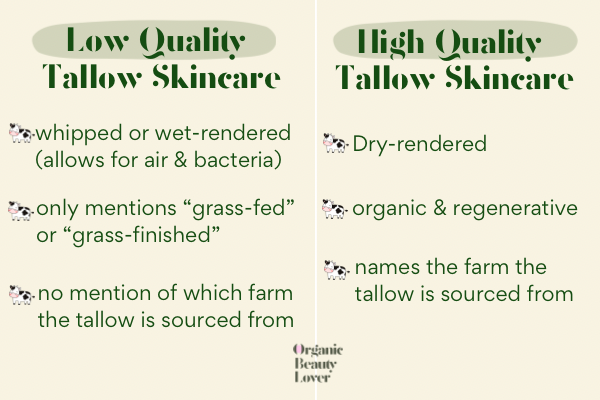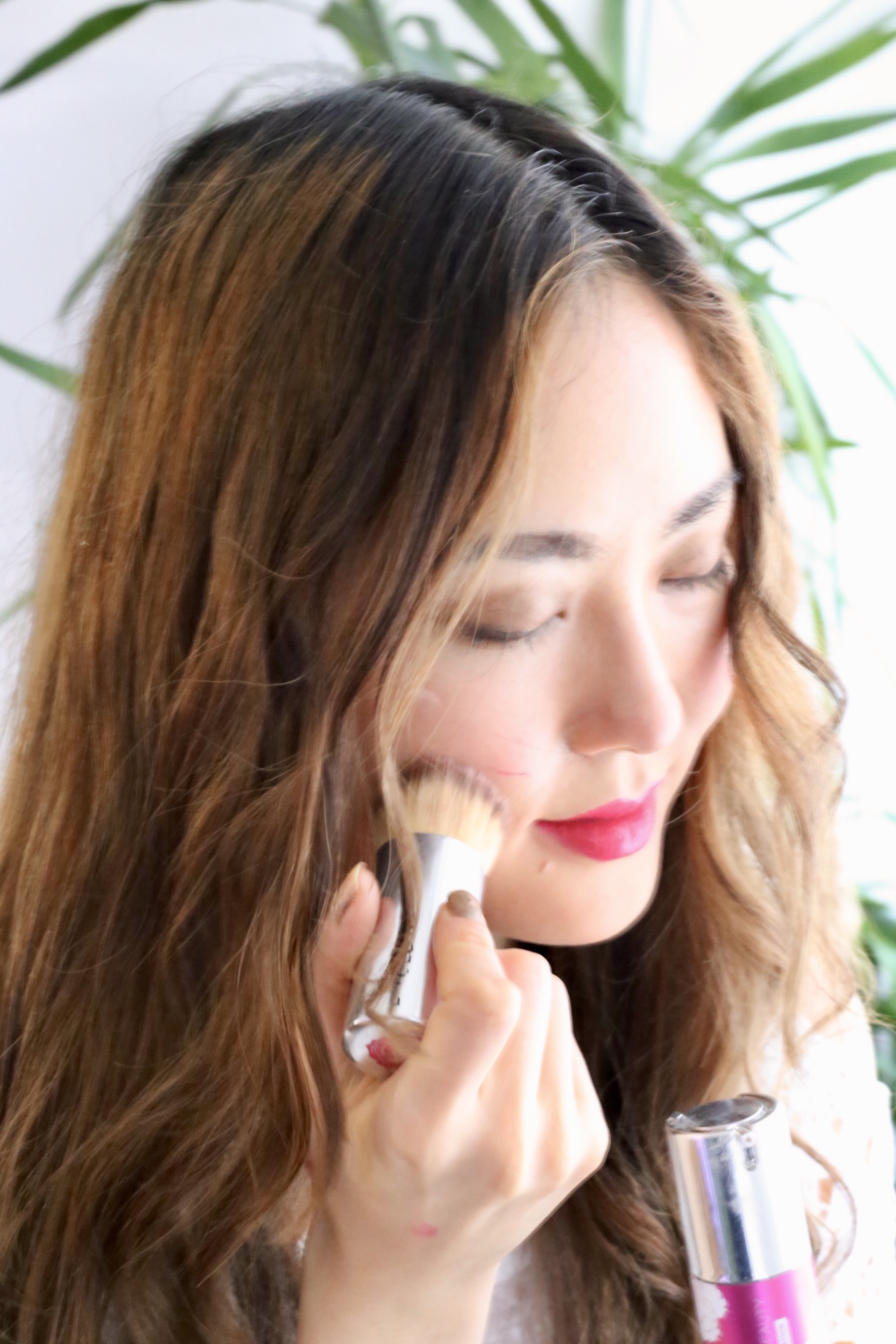I tried a tallow skincare routine for an entire month, and I’m here to dish! I’ll be sharing how to find the BEST tallow moisturizer, the benefits of using it on the face and my experience testing a FULL routine for 30 days (with before and after pics).
The best quality tallow will be free of petroleum-based ingredients, synthetic fragrance, parabens, chemical fragrance and be organic, grass-fed, regenerative, pasture-raised, dry-rendered, non-whipped and handcrafted in small batches and local.

Yes, I tested tallow moisturizers, sunscreen, serum, soap, face oil and lip balms for a month to see if it’s superior to non animal-based skincare. And yes, it did make me gag. Here’s the thing, quality matters and not all beef fats are created equal.


How to find THE BEST tallow for skin
Let me be the first to tell you that most tallow brands can’t even trace where theirs comes from. In fact, they don’t even know if they’re using fresh tallow at all. Tallow is the rendered fat from the suet of cattle that’s raised for meat. Specifically, it comes from the fat surrounding the loins and kidneys.
First, avoid brands that ONLY mention “grass fed” like the plague. Knowing how horrible the meat industry is in the US, I couldn’t use the bodies of precious animals who have lived in horrific conditions, never having seen the sun or roamed free. If a brand can’t say anything else beyond “grass-fed” and “natural” that is a huuuuge RED FLAG! Just say no. This is a dead giveaway that the company does not know anything else about their own tallow and most likely uses a manufacturer that mass-produces products for dozens of brands.
Be sure to look for more information or certifications beyond just “grass-fed.” Do they know which farm the beef fat comes from? Can they tell you (or see themselves) how the cattle is raised? If it’s a no to any of these, it’s a pass for me.
Second, let me be the first to tell you that “whipped tallow” is a cheap and amateur way of making tallow. Avoid whipped as well as wet-rendered tallow. Whipped tallow may be more pleasant to use, but it’s a sign of low quality AND you get way less product. You’re basically paying for air! These methods can introduce bacteria and mold into products. Choose dry-rendered instead. The consistency is going to be way denser but it’s going to be packed with way more nutrients.

Benefits of Tallow Skincare (why it might be better than plant-based)!
Some people think that beef fat skincare actually works like botox for them! This has been debunked but if you see results to that effect, more power to you! But it’s true that there are incredible benefits to using tallow skincare because of how intensely healing and nourishing it is.
Most skincare is now made using petroleum-derived products, many of which do absolutely nothing for the skin except coat it, if not harm it. Tallow has been historically used for millennia and is readily absorbable, suuuper abundant in fat-soluble vitamins and minerals and safe for all skin types. However, I would not recommend for active acne flare-ups because of its high oleic acid content!
It can effectively address skin’s vital needs for skin barrier protection, moisture retention and anti-inflammation thanks to its unique properties and composition. Rendered beef fat is:
- Packed with fatty acids including oleic, palmitic, stearic, alpha-linoleic, and conjugated linoleic (CLA)
- Composed of 50% saturated fat, 42% monounsaturated fat, and 4% polyunsaturated fat
- High in vitamin A, vitamin D, vitamin E, and K
- Its composition closely mimics human skin oils (sebum)
- Low comedogenic profile (doesn’t clog pores but acne-prone skin should proceed with caution!)
Who shouldn’t use tallow
Those with active breakouts, acne prone skin and easily clogged pores should avoid using tallow. Tallow is extremely heavy and can exacerbate certain skin issues.

My honest review (before and after photos)
These are my untouched before and after photos from using tallow balm for a full month. Would I say it transformed my skin? No, I saw some improvements, but nothing that any good and consistent clean skincare routine that matches your skin type wouldn’t bring you. I do feel that mature skin and troubled skin, like a broken skin barrier or inflamed skin, would benefit the most. Here’s a breakdown of what I tested.
For my cleanser, I used a tallow soap bar to remove makeup and clean my pores. Then I used a zinc oxide tallow sunscreen during the day and tallow moisturizer followed by a tallow face oil at night. For my lips I tried both lip balms and lip salves. The brand Vintage Tradition was my least favorite. I’ve noticed a lot of people say a certain brand’s face cream isn’t greasy or heavy, but if it has a certain amount of tallow (which you’d want it to), I found there’s no getting around the fact that it’s going to feel greasier than a typical water-based moisturizer. I used whipped face creams and still found the finish to be quite oily! An alternative I’d suggest is to use a non-tallow face cream followed up with a tallow face oil. I was blown away by Summer Solace Emanations Nourishing Oil, which has regenerative organic tallow, emu oil, ratfish liver oil, rose oil and a gorgeous attar.
I also found that tallow soaps are definitely the most nourishing soaps I have eeeever used. They give the creamiest lather ever and feel like a watery milk cleanser on my skin! There’s something really special about them versus regular palm oil- based soaps. Highly highly recommend giving cow fat bar soaps a try! One thing I disliked about certain products I tested was the distinct and slightly off-putting scent. Not gonna lie, it made me wanna gag a little. On the bright side, I found the scent isn’t noticeable anymore after a minute. But not all products have the typical “tallow odor” since some use essential oils or floral extracts. So if you have a sensitive nose, I would definitely recommend going for one that has those extra ingredients to make it smell better.

Honestly, after using straightup controversial cow fat on my face I felt like my skin became softer, more moisturized and supple. My lips also never felt more moisturized. I would say pass on the lip balm in a tube though because I didn’t feel like they were any better than my favorite organic lip balms. Tallow lip salves I was very impressed by on the other hand. The drawbacks of using tallow for me were the product feeling heavier on my skin, some just smelled plain old funky and grappling with the fact that I’m using dead cow parts for vanity reasons.

I’m surprised by how much I enjoyed grass-fed tallow sunscreen! I tried Sky & Sol’s Face Sunscreen, which feels very much like a light, hydrating lotion and Summer Solace’s which is a dense, rich zinc oxide balm. I love that both companies use fuss-free ingredients of tallow mixed with zinc oxide and a couple oils or butters. Sky & Sol was the simplest tallow sunscreen I tried and would be great for sensitive skin because the ingredients are so minimal (just tallow, jojoba oil, beeswax, and propolis). I find that it also absorbs very well leaving almost no white cast and has no scent. Summer Solace’s come in tinted and non-tinted versions and have either a chamomile scent or herbal scent.
I’ve come to the conclusion that some brands were very underwhelming to me while others knocked my socks off. After trying various popular natural tallow skincare brands, I could feel a major quality difference between mass manufactured grass-fed products versus the ones that tick all my boxes (organic, small-batch, pasture-raised, etc). The former is going to be a lot easier on your wallet, but if your budget can handle it, I would recommend going with the latter ten times out of ten. Trust me, your skin will thank you. The only brand I’ve come across so far that meets my standards is Summer Solace Tallow.
I have no doubt that majority of tallow skincare companies out there are all using the same manufacturers who mass produce their products from sad cows all over the country. Summer Solace actually makes their own tallow using verified regenerative suet from Stemple Creek Ranch located just 30 miles away from them. They dry-render it using slow, traditional methods and infuse it with organic, local, regional and seasonal ingredients that are a cut above the rest. They are truly in a league of their own. Plus there’s no icky smell.
My final thoughts
So is beef fat for skin worth the hype? The answer, in my opinion, is it depends on what brand you buy from. Low quality tallow face creams are a no for me, even if they have a small price tag. They’re just not worth it to me and never will be. I am a thousand percent yes on brands that meet my standard of quality and mindfully and ethically create products with care for the animal and land.
Read the latest!


Andrea is a clean beauty expert from Los Angeles, California with 10 years of experience in natural skincare and organic living. She writes for Organic Beauty Lover using her expertise to guide readers in choosing the best clean products. Andrea graduated from the University of Southern California in 2012 and has worked at multiple skincare companies, big and small. Connect with her @organicbeautylover.








Leave a Reply